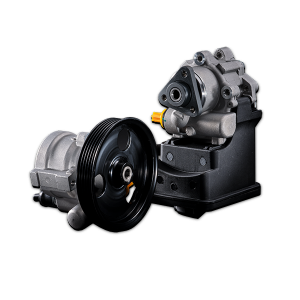
Power Steering Pump Installation Guide
11 Feb 2025
Category:
To guarantee the performance of the replacement Power Steering Pump, it is important that the following steps are observed in order.
Steering components within the system may retain residue or debris from the old system and contaminate the new pump, immediately voiding the warranty if this process is not followed.
A failure to flush and bleed the system correctly can result in a lack of pressure, noisy or heavy operation, and in some cases, a bubbling of the power steering fluid or total failure of the newly installed pump.
Before Installation
- Determine the cause of failure and repair as necessary. Failure to do so may lead to premature failure of the new pump.
- Compare the replacement pump with the removed pump to ensure fixings, connections, and pulleys all match.
- Disconnect the hoses and ensure they are blanked off.
- Inspect the condition of the hoses and the relevant O-rings. If the hose feels still, hard, or spongy, replace all hoses in the system. As the hoses are all made of the same compound and were likely fitted at the same time, one deteriorated hose is a likely indication that the others will be in a similar condition.
- Remove the PAS Pump.
- On some applications, the original PAS Pump Pulley will have to be transferred to the new PAS Pump.
- To ensure the PAS system is free of any debris that may have caused the original failure, drain and flush the system with 5-6 litres of PAS Fluid. Refer to the owner’s manual or manufacturer’s specifications to determine the correct fluid to be used in the power steering system. ONLY USE RECOMMENDED FLUIDS.

Installation
- Install the new PAS Pump and Drive Belt.
- Adjust according to the vehicle manufacturer’s settings.
- Re-install the hoses.
- Fill the PAS system with the vehicle manufacturer’s recommended fluid.
Bleeding The System
- With no load on the front axle (wheels raised off the round), perform two slow steering wheel turns from lock to lock.
- Refill the pump reservoir to maximum level.
- Start the engine and make sure that the pump reservoir always contains fluid to prevent air being sucked into the system. DO NOT RUN THE PUMP DRY.
- Perform several slow steering turns from lock to lock, to remove any trapped air in the system.
- Perform a visual inspection and check for leaks.
- Switch off the engine and check how far the fluid rises in the pump reservoir. If the fluid rises more than approximately 5mm in the reservoir, repeat the bleeding process.
After Installation
- Recheck the fluid level and top-up if required.
- Road test the vehicle.
- On completion, please make a final check on the PAS fluid level and top up again if required.
DRIVE YOUR S&S KNOW HOW
Do you have further queries? For in-person support, book a TechMate visit today! Contact the team on 01174 288090. All other technical support is available via our expert NAPA Technical Team on 03333 136597 or email [email protected].
Chevrolet Spark Clutch Fitment Guide
A rattle generated from the clutch fork/release bearing area may be evident after a new...
Read MoreKia Sportage Clutch Fitment Guide
When installing a new clutch kit to the Kia Sportage CRDI (1.7, 2010-2015), you may...
Read MoreFuel Filter Fitment Guide - NFF2122
When replacing the fuel filter, it’s important to ensure correct fitment is followed. Keep the...
Read More